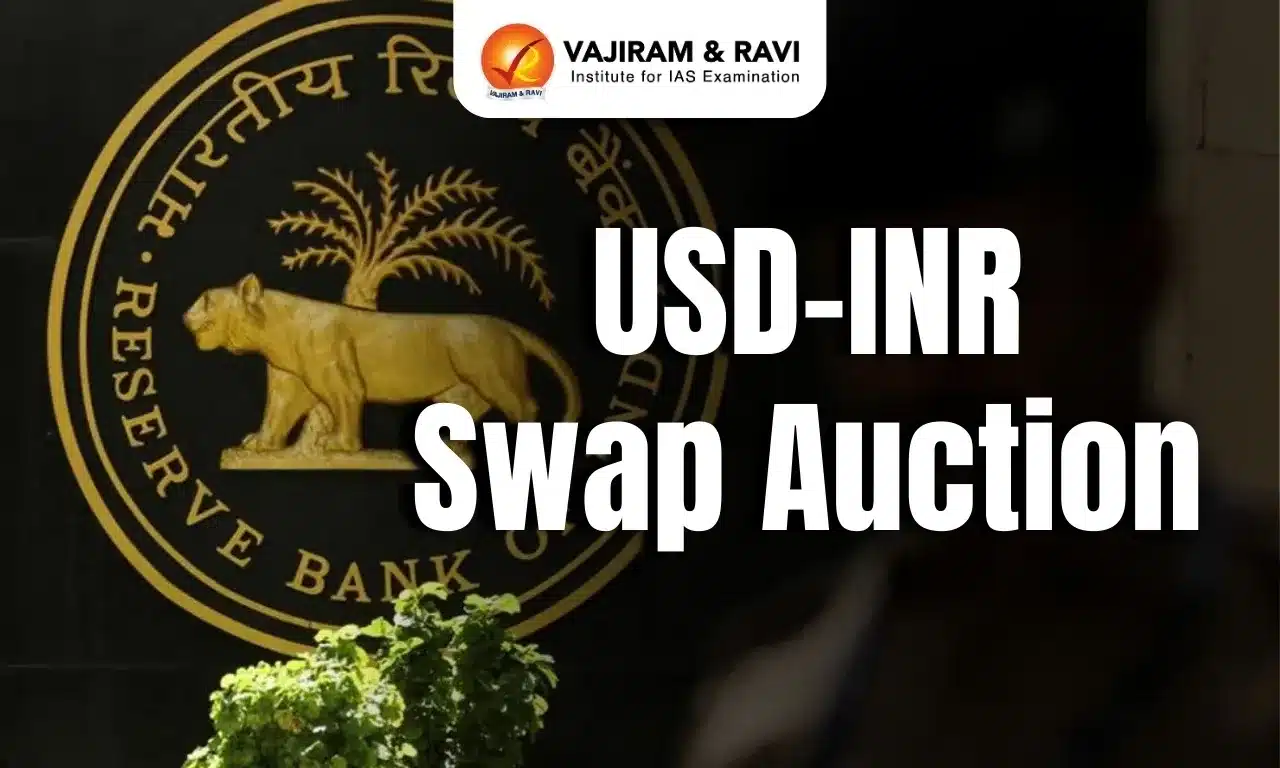What’s in Today’s Article?
- USD-INR swap auction Latest News
- Dollar/rupee buy-sell swap auction
- RBI’s USD-INR Buy/Sell Swap Auction for Liquidity Management
- USD-INR swap auction FAQs
USD-INR Swap Auction Latest News
- The Reserve Bank of India (RBI) will conduct its largest-ever $10-billion dollar/rupee buy-sell swap auction, aiming to address the persistent liquidity deficit in the banking system.
Dollar/Rupee Buy-Sell Swap Auction
- A Dollar/Rupee Buy-Sell Swap Auction is a foreign exchange (forex) instrument used by the Reserve Bank of India (RBI) to manage liquidity in the financial system.
- In this mechanism, RBI buys U.S. Dollars from banks in exchange for Rupees (first leg) and agrees to sell them back at a pre-determined future date along with a premium (reverse leg).
Need for Swap Auctions
- Liquidity Management: Helps inject or absorb Rupee liquidity in the banking system.
- Exchange Rate Stability: Reduces volatility in the USD/INR exchange rate by providing liquidity buffers.
- Foreign Exchange Reserves Management: Enhances the efficient utilization of forex reserves.
- Inflation & Interest Rate Control: Manages liquidity, indirectly influencing inflation and interest rates.
Advantages
- Enhances Market Liquidity: Provides long-term liquidity to banks, supporting credit flow.
- Stabilizes the Rupee: Helps mitigate pressure on the Rupee during periods of forex outflows.
- Predictable Cash Flows for Banks: Assists banks in managing forex positions and liquidity planning.
- Prevents Excessive Volatility: Helps smoothen currency fluctuations, boosting investor confidence.
Challenges
- Impact on Forex Reserves: Large-scale swaps can affect RBI’s forex reserves.
- Dependence on External Factors: Effectiveness depends on global market conditions, capital flows, and interest rate differentials.
- Market Reaction Uncertainty: If not executed strategically, it may lead to unintended currency speculation.
- Limited Long-Term Solution: Provides only a temporary fix for liquidity issues; structural reforms may still be needed.
RBI’s USD-INR Buy/Sell Swap Auction for Liquidity Management
- To address the system’s durable liquidity needs, the Reserve Bank of India (RBI) will conduct a USD-INR Buy/Sell swap auction worth $10 billion for a three-year tenor on February 28, 2025.
- The spot settlement date is March 4, 2025, while the far-leg settlement date is March 6, 2028.
- This swap auction will provide short-term stability to the Rupee, helping mitigate volatility caused by foreign fund outflows.
- The USD-INR spot rate may move towards 86.30.
Swap Mechanism
- In the first leg, participating banks will sell USD to the RBI at the FBIL Reference Rate and receive equivalent Rupee liquidity in their current accounts.
- The FBIL Reference Rate is a benchmark rate for currency pairs, such as the Indian rupee (INR) against the US dollar (USD), euro (EUR), pound sterling (GBP), and Japanese yen (JPY).
- FBIL stands for Financial Benchmarks India Private Limited.
- In the reverse leg, banks will repurchase USD from the RBI by returning the Rupee funds along with the agreed swap premium.
- This strategic move by the RBI aims to enhance liquidity, stabilize the Rupee, and maintain exchange rate stability.
USD-INR Swap Auction FAQs
Q1. What is the objective of the dollar-rupee swap arrangement implemented by the RBI?
Ans. RBI aims to manage liquidity, stabilize the Rupee, and reduce forex market volatility through USD-INR swap arrangements.
Q2. What is a buy-sell swap?
Ans. In a buy-sell swap, RBI buys USD from banks and agrees to sell it back later at a pre-fixed exchange rate.
Q3. Why does RBI sell dollars when the Rupee depreciates?
Ans. RBI sells dollars to increase USD supply, support the Rupee, and curb excessive volatility in the forex market.
Q4. What is the concept of a currency swap?
Ans. A currency swap is an agreement to exchange currencies at a set rate, often used to manage liquidity and forex reserves.
Q5. What happens if the Rupee weakens against the Dollar?
Ans. A weaker Rupee makes imports costlier, increases inflation, and may lead to RBI interventions to stabilize the currency.
Last updated on June, 2025
→ UPSC Notification 2025 was released on 22nd January 2025.
→ UPSC Prelims Result 2025 is out now for the CSE held on 25 May 2025.
→ UPSC Prelims Question Paper 2025 and Unofficial Prelims Answer Key 2025 are available now.
→ UPSC Calendar 2026 is released on 15th May, 2025.
→ The UPSC Vacancy 2025 were released 1129, out of which 979 were for UPSC CSE and remaining 150 are for UPSC IFoS.
→ UPSC Mains 2025 will be conducted on 22nd August 2025.
→ UPSC Prelims 2026 will be conducted on 24th May, 2026 & UPSC Mains 2026 will be conducted on 21st August 2026.
→ The UPSC Selection Process is of 3 stages-Prelims, Mains and Interview.
→ UPSC Result 2024 is released with latest UPSC Marksheet 2024. Check Now!
→ UPSC Toppers List 2024 is released now. Shakti Dubey is UPSC AIR 1 2024 Topper.
→ Also check Best IAS Coaching in Delhi
























